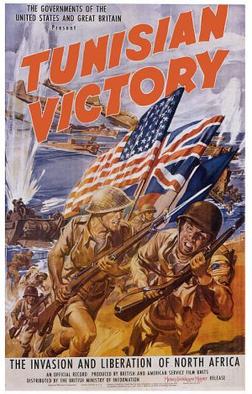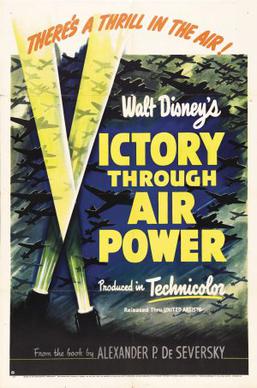Related Research Articles

Why We Fight is a series of seven propaganda films produced by the US Department of War from 1942 to 1945, during World War II. It was originally written for American soldiers to help them understand why the United States was involved in the war, but US President Franklin Roosevelt ordered distribution for public viewing.

Victory gardens, also called war gardens or food gardens for defense, were vegetable, fruit, and herb gardens planted at private residences and public parks in the United States, United Kingdom, Canada, Australia and Germany during World War I and World War II. In wartime, governments encouraged people to plant victory gardens not only to supplement their rations but also to boost morale. They were used along with rationing stamps and cards to reduce pressure on the food supply. Besides indirectly aiding the war effort, these gardens were also considered a civil "morale booster" in that gardeners could feel empowered by their contribution of labor and rewarded by the produce grown. This made victory gardens a part of daily life on the home front.

The United States Office of War Information (OWI) was a United States government agency created during World War II. The OWI operated from June 1942 until September 1945. Through radio broadcasts, newspapers, posters, photographs, films and other forms of media, the OWI was the connection between the battlefront and civilian communities. The office also established several overseas branches, which launched a large-scale information and propaganda campaign abroad. From 1942 to 1945, the OWI revised or discarded any film scripts reviewed by them that portrayed the United States in a negative light, including anti-war material.

The Battle of Russia (1943) is the fifth film of Frank Capra's Why We Fight documentary series. The longest film of the series, it has two parts. It was made in collaboration with Russian-born Anatole Litvak as primary director under Capra's supervision. Litvak gave the film its "shape and orientation," and the film had seven writers with voice narration by Walter Huston. The score was done by the Russian-born Hollywood composer Dimitri Tiomkin and drew heavily on Tchaikovsky along with traditional Russian folk songs and ballads.

Prelude to War is the first film of Frank Capra's Why We Fight film series commissioned by the Office of War Information (OWI) and George C. Marshall. It was made to educate American troops of the necessity of combating the Axis powers during World War II based on the idea that those in the service would fight more willingly and ably if they knew the background and the reason for their participation in the war. The film was later released to the general American public as a rallying cry for support of the war.

The New Spirit is a 1942 American animated short film produced by Walt Disney Productions and the U.S. Department of the Treasury, and released by the War Activities Committee of the Motion Pictures Industry. The cartoon, which stars Donald Duck, was the first film created as part of Walt Disney's World War II propaganda production. It was commissioned by Henry Morgenthau Jr., then Secretary of the Treasury, to encourage American citizens to pay their income tax in support of the war effort. The film was directed by Wilfred Jackson and Ben Sharpsteen, and features Clarence Nash as the voice of Donald, Fred Shields as the radio announcer, and Cliff Edwards singing the theme song.

Tunisian Victory is a 1944 Anglo-American propaganda film about the victories in the North Africa Campaign.

The True Glory (1945) is a co-production of the US Office of War Information and the British Ministry of Information, documenting the victory on the Western Front, from Normandy to the collapse of the Third Reich.
Black Marketing is an American 1943 dramatic propaganda documentary short produced by the United States Office of War Information and directed by William Castle. It is an educational film warning American civilians against buying unrationed foodstuffs and materials.

Desert Victory is a 1943 film produced by the British Ministry of Information, documenting the Allies' North African campaign against Field Marshal Erwin Rommel and the Afrika Korps. This documentary traces the struggle between General Erwin Rommel and Field Marshal Bernard Montgomery, from the German's defeat at El Alamein to Tripoli. The film was produced by David MacDonald and directed by Roy Boulting who also directed Tunisian Victory and Burma Victory. Like the famous "Why We Fight" series of films by Frank Capra, Desert Victory relies heavily on captured German newsreel footage. Many of the most famous sequences in the film have been excerpted and appear with frequency in History Channel and A&E productions. The film won a special Oscar in 1943 and the 1951 film The Desert Fox: The Story of Rommel took sections of the film for its battle footage.
Between 1941 and 1945, during World War II, Walt Disney was involved in the production of propaganda films for the U.S. government. The widespread familiarity of Disney's productions benefited the U.S. government in producing pro-American war propaganda in an effort to increase support for the war.
The following outline is provided as an overview of and topical guide to World War II:

Beyond the Line of Duty is a 1942 American short propaganda film, directed by Lewis Seiler. The documentary film reenacted the life and career of United States Army Air Corps Captain Hewitt T. "Shorty" Wheless.

Victory Through Air Power is a 1943 American Technicolor animated documentary propaganda film produced by Walt Disney Productions and released by United Artists on July 17, 1943. It is based on the 1942 book Victory Through Air Power by Alexander P. de Seversky. De Seversky appeared in the film, an unusual departure from the Disney animated feature films of the time.
Anthony Veiller was an American screenwriter and film producer. He wrote for 41 films between 1934 and 1964.
Conquer by the Clock was a short dramatic propaganda film produced by the RKO Pathé in 1942 to encourage wartime industrial production. It was nominated for an Academy Award for Best Documentary Feature in 1943.

The Grain That Built a Hemisphere is a 1943 short animated propaganda film about corn produced by Walt Disney for the Office of the Coordinator of Inter-American Affairs. It was nominated for an Academy Award for Best Documentary in 1943.
The Price of Victory is a 1942 short propaganda film produced by Paramount Pictures and the U.S. Office of War Information. It was nominated for an Academy Award for Best Documentary Feature in 1943.
A Ship Is Born is a 1942 short WWII propaganda film produced by Warner Bros. about the U.S. Merchant Marine. It was nominated for an Academy Award for Best Documentary Feature in 1943.

Five Came Back is an American documentary based on the 2014 book Five Came Back: A Story of Hollywood and the Second World War by journalist Mark Harris. It was released as a stand-alone documentary in New York and Los Angeles, and as a three-part series on Netflix, on March 31, 2017.
References
- ↑ Awards for 1943 in IMDB